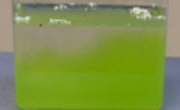연안 및 도서 지역의 인프라 시설물 건설을 위한 해수 콘크리트의 활용은 물 부족 등의 지구환경적 문제에 대응하기 위한 하 나의 지속가능한 해법이 될 수 있다. 그러나 해수를 콘크리트용 ...
http://chineseinput.net/에서 pinyin(병음)방식으로 중국어를 변환할 수 있습니다.
변환된 중국어를 복사하여 사용하시면 됩니다.
- 中文 을 입력하시려면 zhongwen을 입력하시고 space를누르시면됩니다.
- 北京 을 입력하시려면 beijing을 입력하시고 space를 누르시면 됩니다.

폴리 염화 알루미늄 수용액을 사용한 해수 배합 시멘트 페이스트의 특성 평가 = Evaluation on Properties of Sea Water Cement Paste Made of Poly-Aluminum Chloride Solution
한글로보기https://www.riss.kr/link?id=A109440787
- 저자
- 발행기관
- 학술지명
- 권호사항
-
발행연도
2024
-
작성언어
Korean
-
주제어
해수 ; 폴리 염화 알루미늄 ; 시멘트 페이스트 ; 수화반응 ; 강도 ; seawater ; poly-aluminum chloride ; cement paste ; hydration ; strength
-
등재정보
KCI등재
-
자료형태
학술저널
-
수록면
651-661(11쪽)
- DOI식별코드
- 제공처
-
0
상세조회 -
0
다운로드
부가정보
국문 초록 (Abstract)
연안 및 도서 지역의 인프라 시설물 건설을 위한 해수 콘크리트의 활용은 물 부족 등의 지구환경적 문제에 대응하기 위한 하 나의 지속가능한 해법이 될 수 있다. 그러나 해수를 콘크리트용 배합수로 사용하게 되면 콘크리트 내부에 매설된 철근의 부식 및 콘크리트 장기강도 저하 등의 문제가 발생하기 때문에 사용이 제한되어져 왔다. 본 연구에서는 해수 사용시 발생하는 강도 저하의 문제를 극복하기 위한 방안으로, 수처리 공정에서 활용되는 폴리 염화 알루미늄(PAC) 수용액을 활용하고자 하였다. 폴 리 염화 알루미늄 수용액은 염소 및 알루미늄이 이온의 형태로 용해되어져 있어, 시멘트의 수화반응 촉진이 가능한데, 특히 용 해된 알루미늄의 존재로 인해 시멘트 페이스트 내부에 칼슘 실리케이트 및 알루미네이트 수화물의 생성을 촉진하여 강도 발현 을 상승시킬 가능성이 존재하기 때문이다. 이를 위해 본 연구에서는 초순수 및 해수로 제조된 시멘트 페이스트에 다양한 농도 의 PAC 수용액을 넣어, 수화반응성 및 강도발현특성을 비교 분석하였다. 실험 결과에 따르면, 해수로 시멘트 페이스트의 초기 수화반응을 촉진하는 동시에 28일 재령 강도를 떨어뜨리며, 수돗물에서 양생한 경우보다 해수에서 양생한 경우 강도의 저하 폭이 더욱 크게 나타났다. 초순수 및 해수 사용 여부와 무관하게, PAC 농도 0.8%에서 최대 압축강도를 보였고, 0.8% 이상의 농 도에서는 농도가 증가할수록 수화반응이 지연되고 압축강도 또한 감소하는 것으로 나타났다. 다만 현재까지의 연구 결과로 얻 은 0.8%의 PAC 농도가 최적의 농도인지에 대한 부분은 보다 정밀한 분석을 통한 추후 연구로 밝혀내야 할 것으로 보인다.
다국어 초록 (Multilingual Abstract)
The use of seawater concrete for the construction of infrastructure facilities in coastal and island areas can be a sustainable solution to address global environmental problems such as water shortage. However, the use of seawater has been limited for...
The use of seawater concrete for the construction of infrastructure facilities in coastal and island areas can be a sustainable solution to address global environmental problems such as water shortage. However, the use of seawater has been limited for reinforced concrete due to the rebar corrosion and loss of long-term strength. In this study, poly-aluminum chloride(PAC) aqueous solution was used to overcome the reduction in strength since the amount of dissolved aluminum is higher and thus promotes the ettringite formation in early age to prevent loss of strength at 28 day. For this purpose, various concentrations of PAC solution were added to cement paste made of deionized and sea water, and the hydration and strength development were evaluated. According to the experimental results, seawater promoted the initial hydration of the cement paste and reduced 28 day compressive strength. The reduction in strength was greater when cement paste was cured in seawater. Regardless of whether deionized or sea water was used, the maximum compressive strength was shown at a PAC concentration of 0.8%. Above 0.8% concentration, the hydration was delayed and the compressive strength decreased as PAC concentration increased. However, it should be noted that a further research needs to be conducted to clarify whether 0.8% PAC concentration was the optimal concentration or not.
동일학술지(권/호) 다른 논문
-
hBN (Hexagonal Boron Nitride)을 혼입한 모르타르의 기초물성과 중성자 차폐성능 분석
- 한국건축시공학회
- 서태석
- 2024
- KCI등재
-
공사감리보고서의 비정형 데이터를 이용한 건축 프로젝트 환경성과 추정모형 개발
- 한국건축시공학회
- 서정훈
- 2024
- KCI등재
-
- 한국건축시공학회
- 이호일
- 2024
- KCI등재
-
- 한국건축시공학회
- 김한식
- 2024
- KCI등재




 ScienceON
ScienceON KISS
KISS






